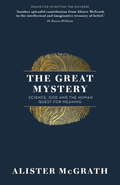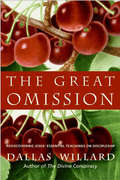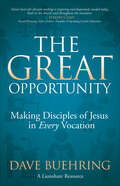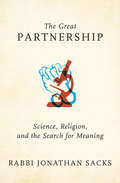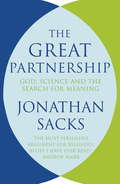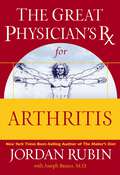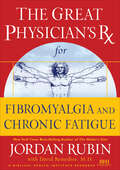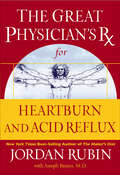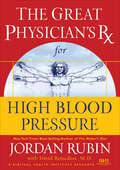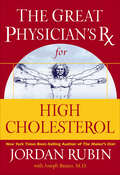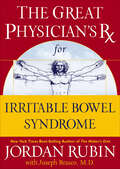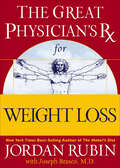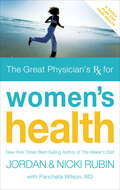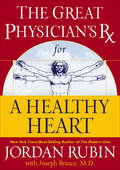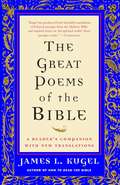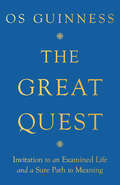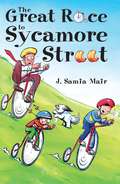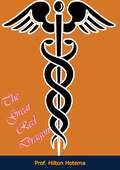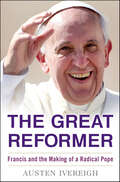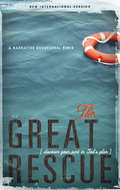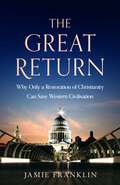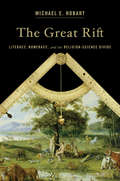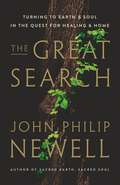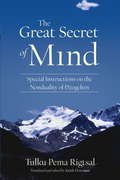- Table View
- List View
The Great Mystery: Science, God and the Human Quest for Meaning
by Dr Alister E McGrathThere is currently huge interest in the question of human nature and identity, and what the human future might look like. Who are we? Why are we here? What is our future? Are we alone? And what can religion bring, alongside biology and anthropology, to these important and exciting questions?The Great Mystery focuses on this fascinating field of study. Alister McGrath, bestselling author and Andreas Idreos Professor of Science and Religion at Oxford University, explores the question of human nature from both scientific and religious perspectives, and weaves together the results to open up and explore some of the deepest and most important questions about who we are, why we matter, and what our future might be. A follow-up to his critically acclaimed Inventing the Universe, in The Great Mystery Alister McGrath once again brings together science with religion to yield an enriched vision of reality, along with rigorous and thoroughly up-to-date scholarship and intellectual accessibility.
The Great Omission: Reclaiming Jesus’s Essential Teachings on Discipleship
by Dallas WillardThe last command Jesus gave the church before he ascended to heaven was the Great Commission, the call for Christians to "make disciples of all the nations." But Christians have responded by making "Christians," not "disciples." This, according to brilliant scholar and renowned Christian thinker Dallas Willard, has been the church's Great Omission."The word disciple occurs 269 times in the New Testament," writes Willard. "Christian is found three times and was first introduced to refer precisely to disciples of Jesus. . . . The New Testament is a book about disciples, by disciples, and for disciples of Jesus Christ. But the point is not merely verbal. What is more important is that the kind of life we see in the earliest church is that of a special type of person. All of the assurances and benefits offered to humankind in the gospel evidently presuppose such a life and do not make realistic sense apart from it. The disciple of Jesus is not the deluxe or heavy-duty model of the Christian -- especially padded, textured, streamlined, and empowered for the fast lane on the straight and narrow way. He or she stands on the pages of the New Testament as the first level of basic transportation in the Kingdom of God."Willard boldly challenges the thought that we can be Christians without being disciples, or call ourselves Christians without applying this understanding of life in the Kingdom of God to every aspect of life on earth. He calls on believers to restore what should be the heart of Christianity -- being active disciples of Jesus Christ. Willard shows us that in the school of life, we are apprentices of the Teacher whose brilliance encourages us to rise above traditional church understanding and embrace the true meaning of discipleship -- an active, concrete, 24/7 life with Jesus.
The Great Opportunity: Making Disciples of Jesus in Every Vocation
by Dave BuehringThe Great Opportunity takes Christians beyond knowing that their faith should affect their work by showing them why and how to make disciples among those who share their vocation.
The Great Partnership
by Jonathan SacksAn impassioned, erudite, thoroughly researched, and beautifully reasoned book from one of the most admired religious thinkers of our time that argues not only that science and religion are compatible, but that they complement each other--and that the world needs both. "Atheism deserves better than the new atheists," states Rabbi Jonathan Sacks, "whose methodology consists of criticizing religion without understanding it, quoting texts without contexts, taking exceptions as the rule, confusing folk belief with reflective theology, abusing, mocking, ridiculing, caricaturing, and demonizing religious faith and holding it responsible for the great crimes against humanity. Religion has done harm; I acknowledge that. But the cure for bad religion is good religion, not no religion, just as the cure for bad science is good science, not the abandonment of science." Rabbi Sacks's counterargument is that religion and science are the two essential perspectives that allow us to see the universe in its three-dimensional depth. Science teaches us where we come from. Religion explains to us why we are here. Science is the search for explanation. Religion is the search for meaning. We need scientific explanation to understand nature. We need meaning to understand human behavior. There have been times when religion tried to dominate science. And there have been times, including our own, when it is believed that we can learn all we need to know about meaning and relationships through biochemistry, neuroscience, and evolutionary psychology. In this fascinating look at the interdependence of religion and science, Rabbi Sacks explains why both views are tragically wrong.
The Great Partnership: God, Science And The Search For Meaning
by Jonathan SacksWriting with his usual grace and fluency, Jonathan Sacks moves beyond the tired arguments of militant atheists such as Dawkins and Hitchens, to explore how religion has always played a valuable part in human culture and far from being dismissed as redundant, must be allowed to temper and develop scientific understanding in order for us to be fully human. Ranging around the world to draw comparisons from different cultures, and delving deep into the history of language and of western civilisation, Jonathan Sacks shows how the predominance of science-oriented thinking is embedded deeply even in our religious understanding, and calls on us to recognise the centrality of relationship to true religion, and thus to see how this core value of relationship is essential if we are to avoid the natural tendency for science to rule our lives rather than fulfilling its promise to set us free.
The Great Physician's Rx for Arthritis (The Great Physician's Rx)
by Jordan Rubin Joseph BrascoThe New York Times–bestselling author of The Maker’s Diet uses biblical and natural health concepts to show you how to fight arthritis.Like age, arthritis has a way of creeping up on you until one morning, that occasional stiffness in the knee or soreness in the hands turns into “That hurts!” type of pain. Prolonged physical activity only prolongs the soreness.Arthritis is a general medical term that refers to inflammation of the joints. The word “arthritis” is a blend of the Greek words “arthron” for joint and “it is” for inflammation. Frequent cracking of the joints and early morning stiffness are common symptoms of osteoarthritis, even during pain-free periods. Some will joke that they can tell a weather change is ahead when their knees act up, but that’s because painful joints can be sensitive to a falling of barometric pressure, which signals rain in the forecast.Arthritis often begins subtly with a little ache and stiffness in the knees or shoulders. Or it may herald its arrival with sharp pain and swollen, tender joints. Arthritis takes center stage, however, when you feel as stiff as a board when you pull yourself out of bed in the morning. Stiff spines, creaky necks, and balky backs can zap the life out of even the most optimistic individuals. Those with arthritic hands and wrists find it painful to type or even use a computer mouse, while some with arthritic knees shuffle around with pain as their constant companion. Arthritic hips not also restrict mobility but impact a couple’s love life since arthritic hip pain can make sexual relations painful, particularly for women. No matter how you cope or make lifestyle adjustments, arthritis is a pain to live with.In The Great Physician’s Rx for Arthritis, Jordan Rubin, along with Joseph Brasco, MD, recommends a total lifestyle program for the health of the body, mind, and spirit that’s much more effective than sleeping on a bed of magnets each night, and it’s based on the seven keys to unlock your God-given health potential found in his foundational book The Great Physician’s Rx for Health and Wellness.
The Great Physician's Rx for Fibromyalgia and Chronic Fatigue (The Great Physician's Rx)
by Jordan Rubin David RemediosThe New York Times–bestselling author of The Maker’s Diet shows how to reverse symptoms of fibromyalgia and CFS with biblical and natural health concepts.Chronic fatigue syndrome (CFS) and fibromyalgia present themselves through persistent, overwhelming symptoms of fatigue and feelings of exhaustion as well as symptoms such as persistent headaches, bouts of insomnia, muscle and joint pain, memory lapses, fevers, loss of appetite, mood swings, and sensitivity to light and heat, among others.There are about 4 million Americans with fibromyalgia and 3.7 million who have CFS. Doctors often suggest lifestyle changes or recommend over-the-counter pain relievers or offer to write a prescription for antidepressants to improve sleep. There is no known cure for chronic fatigue syndrome or fibromyalgia, but both respond well to the principles found here in this book. People who embrace this total lifestyle program for the body, mind, and spirit have had amazing results.
The Great Physician's Rx for Heartburn and Acid Reflux (The Great Physician's Rx)
by Jordan Rubin Joseph BrascoThe New York Times–bestselling author of The Maker’s Diet uses biblical and natural health concepts to show you how to improve your gastrointestinal health.Heartburn and acid reflux have a nasty way of defying cure or prevention, but following the Great Physician’s prescription for heartburn and acid reflux can alleviate symptoms and nip more serious problems in the bud. Acid indigestion and burning feelings in the chest often strike in the middle of the night with stabbing chest pain. At 1:30 in the morning, there are not a whole lot of options. Most approach the medicine cabinet with the fervent hope that there are a few Tums left in the bottle.Jordan Rubin, along with Joseph Brasco, MD, is not so sure that taking antacids and powerful proton pump inhibitors best for people’s healing or their health. The Great Physician’s Rx for Heartburn and Acid Reflux reveals a more natural approach to beating heartburn and acid reflux based on the Seven Keys to Health and Wellness.
The Great Physician's Rx for High Blood Pressure (The Great Physician's Rx)
by Jordan Rubin David RemediosThe New York Times–bestselling author of The Maker’s Diet show how to keep your blood pressure in check using biblical and natural health concepts.An estimated one in every three American adults—sixty-five million in all—has high blood pressure, or hypertension. In general, the older you are, the greater your chance of developing high blood pressure. Once high blood pressure develops, it usually lasts a lifetime unless steps are taken to control it.More than two-thirds of the Americans with hypertension are taking at least one medication for their afflictions. Following the Seven Keys that make up the Great Physician’s prescription for health and wellness can set you down the right road toward lowering your high blood pressure and regaining your health. This strategy for defeating hypertension is based on the Seven Keys to unlock your God-given health potential first described in The Great Physician’s Rx for Health and Wellness.
The Great Physician's Rx for High Cholesterol (The Great Physician's Rx)
by Jordan Rubin Joseph BrascoThe New York Times–bestselling author of The Maker’s Diet shows how to keep your cholesterol in check using biblical and natural health concepts.Approximately thirty-seven million adults in this country have high blood cholesterol counts, and 105 million—half the U.S. adult population—have cholesterol levels that are higher than desirable. Modern medicine often points to high cholesterol, along with high blood pressure, as the major cause of cardiovascular disease. However, not all cholesterol is bad. Following the Great Physician’s prescription teaches you the facts about HDL (the “good” cholesterol) and LDL (the “bad” cholesterol) and helps you control cholesterol levels naturally to the healthy range. Showing how to adopt the Seven Keys of Health and Wellness to create a healthy lifestyle, New York Times–bestselling author Jordan Rubin, along with Joseph Brasco, MD, guides you with a plan that keeps cholesterol in balance, giving you a way to live the healthiest and happiest life possible. This foundational book provides you the tools you need to live a long, healthy, and abundant life. If you desire to live life to the fullest, then The Great Physician’s Rx for High Cholesterol is the right resource for you.
The Great Physician's Rx for Irritable Bowel Syndrome (The Great Physician's Rx)
by Jordan Rubin Joseph BrascoThe New York Times–bestselling author of The Maker’s Diet shows how to fight IBS symptoms using biblical and natural health concepts.An estimated thirty million adults and children in this country—ten percent of the population—are plagued by Irritable Bowel Syndrome, or IBS. IBS is not a disease but a painful, life-altering, functional digestive disorder in which the muscular contractions of the digestive tract become irregular and uncoordinated. Certain foods and beverages, as well as anxiety and stress, can trigger symptoms. The nature of those symptoms—like cramps, flatulence, constipation, and diarrhea—are not easy to talk about with others, taking an emotional toll on those afflicted with them. IBS also accounts for $25 billion in direct and indirect costs each year. Enough is enough.In The Great Physician’s Rx for Irritable Bowel Syndrome, New York Times–bestselling author Jordan Rubin, along with Joseph Brasco, MD, shows readers how to apply the Seven Keys to Health and Wellness and naturally fight this painful and debilitating disease. This foundational book provides you the tools you need to live a long, healthy, and abundant life. If you desire to live life to the fullest, then The Great Physician’s Rx for Irritable Bowel Syndrome is for you.
The Great Physician's Rx for Weight Loss (The Great Physician's Rx)
by Jordan Rubin Joseph BrascoThe New York Times–bestselling author of The Maker’s Diet uses biblical and natural health concepts to show you how to lose weight and live better.An estimated sixty-five percent of Americans age twenty and older are overweight. The problem of childhood obesity is growing exponentially. Diets, pills, and surgery are all becoming a normal part of the American lifestyle to battle the nation’s weight-loss dilemma, but there’s no end in sight to the damage that overeating is causing.Now, New York Times–bestselling author Jordan Rubin, along with Joseph Brasco, M.D., takes biblical and natural health concepts and formulates a plan to help you lose weight, get healthy, and live the life of your dreams.Showing how to adopt the Seven Keys of Health and Wellness into your lifestyle, Jordan Rubin guides you with a plan that will help you keep the weight off and give you astounding amounts of energy.This foundational book will provide you the tools you need to live a long, lean, and abundant life. If you desire to live life to the fullest, then The Great Physician’s Rx for Weight Loss is the right resource for you.
The Great Physician's Rx for Women's Health (The Great Physician's Rx)
by Jordan Rubin Nicki Rubin Pancheta WilsonThe New York Times–bestselling author of The Maker’s Diet helps show how to address women’s health issues with biblical and natural health concepts.Women—who are not only responsible for their own health but frequently the health of their husbands, children, and aging parents—are sick and tired of being sick and tired. They simply want more out of life, especially when they are dealing with the health challenges unique to women, like the “baby blues,” breast cancer, menopause, and bone loss. These women want biblically based and medically sound solutions. To them, life is all about thriving, not just surviving.Now, New York Times–bestselling author Jordan Rubin, along with his wife, Nicki, and Pancheta Wilson, MD, take biblical and natural health concepts and formulate a plan to help you transform your health and live the life of your dreams.The Great Physician’s Rx for Women’s Health will empower you to achieve maximum energy, attain your ideal weight, enhance your immune system, improve your digestion, reduce your risk for diseases such as breast cancer and osteoporosis, and best of all, make this the healthiest year of your life.If you desire to run the race of life with excellence, then The Great Physician’s Rx for Women’s Health is your road map.
The Great Physician's Rx for a Healthy Heart (The Great Physician's Rx #6)
by Jordan Rubin Joseph BrascoThe New York Times–bestselling author of The Maker’s Diet shows how to improve heart health with biblical and natural health concepts.Of the estimated 700,000 Americans who are hit with a heart attack each year, an estimated 180,000 will not survive. Heart attacks and other cardiovascular diseases are this country’s number one cause of death. The good news is what you do today can prevent you from being one of those statistics. Now, New York Times–bestselling author Jordan Rubin, along with Joseph Brasco, MD, takes biblical and natural health concepts and medically formulates a plan to help lengthen your life and prevent serious heart conditions.Showing how to adopt the Seven Keys of Health and Wellness into your lifestyle, Rubin guides you with a plan that will:give you the best possible chance to live a long, healthy life without ever developing cardiovascular diseaseaugment whatever therapy—conventional or alternative—you’re seeking to treat your heart diseaseThis foundational book will give you the tools you need to live a long and abundant life. If you desire to live life to the fullest, then The Great Physician’s Rx for a Healthy Heart is the right resource for you.
The Great Poems of the Bible: A Reader's Companion with New Translations
by James L. KugelFrom the Psalms to the Prophets, from job to Ecclesiastes, much of the Bible is written in poetry. The poems of the Bible include some of its best known and most beloved passages: "The Lord is my shepherd," "Let justice roll down like waters," "By the rivers of Babylon," "Remember your Creator," "Arise, shine, for thy light is come!" These poems live in the hearts of those who are familiar with the Bible and offer rich rewards to anyone who is approaching the world's greatest book for the first time.In The Great Poems of the Bible, Harvard scholar James Kugel presents original translations of the most beautiful and important poems of the Scripture. Taken together, these poems represent the very essence of the Hebrew Bible. Reading them one after another is like taking a guided tour through Scripture, meeting firsthand some of its most important teachings and opening the way to an understanding of the Bible as a whole.Each poem is accompanied by an eloquent and accessible explanation of the poem's language, and a reflection on its meaning. These learned, compact essays introduce readers to the broader spiritual world of ancient Israel. What did people in biblical times believe about God? Where is a person's soul located and what does it do? Is there an afterlife? How does one come to "know" God? Why wasn't Eve meant to be Adam's "helpmate" (Kugel shows how this was just a translator's slip-up), and what does the Bible have to say about the role of women?Kugel's sparkling translations of the poems, together with the fascinating insights that accompany them, distill the very best that the Bible and modern scholarship have to offer. Kugel brings new life to some of history's greatest poems, and offers a new look at a Bible we thought we already knew. Here, in one volume, is a "Bible's bible" that belongs in every home.
The Great Quest: Invitation to an Examined Life and a Sure Path to Meaning
by Os Guinness"The unexamined life is not worth living." —Socrates
The Great Race to Sycamore Street
by J. Samia MairThis topsy turvy adventure on Sycamore Street sees brother and sister Hude and Amani arrive in the country with one thought: it was going to be a long, boring summer.They couldn't be more wrong.With Grandma Hana's new neighbour planning to pull down her prized peach tree and a gang, led by the archer Bobby, marshalling the local lake, Hude and Amani have a hard time getting any peace.In this warm and comical story, find out how, under the watchful eyes of Grandma Hana, Hude and Amani plan to save the peach tree and beat Bobby at his own game before leaving Sycamore Street behind.J. Samia Mair has published two children's books with The Islamic Foundation, Amira's Totally Chocolate World and The Perfect Gift, which have been favourably received. She is currently a staff writer for SISTERS Magazine. Additionally, she has published articles, stories, and poems in books, magazines, anthologies, scientific journals, online news sources, and elsewhere. This is her first chapter book for kids. She lives in Odenton, Maryland.
The Great Red Dragon
by Hilton HotemaIn the Great Red Dragon Hotema explains how all ancient religions were based on Grand Cosmic Unity. That bibles were put together along hundreds of years originally to please Constantine and compiled from what was culled from Ptolemy's vast literary scrolls and manuscripts. For instance the Twelve Signs of the Zodiac became the Twelve Apostles, and many other alterations. In addition within the pages of this book Hotema expounds upon masturbation and warns against excessive copulation which can negatively accelerates the aging illusion of the physical system. The greater the pleasure experienced thru the physical, the greater damage suffered by the mental.Hilton Hotema is the author of numerous books on dietetics, fasting, fruitarianism, breatharianism, vitality, cellular regeneration, longevity, higher consciousness, spirituality, alternative medicine and ancient wisdom.
The Great Reformer: Francis and the Making of a Radical Pope
by Austen IvereighA biography of Pope Francis that describes how this revolutionary thinker will use the power of his position to challenge and redirect one of the world's most formidable religionsAn expansive and deeply contextual work, at its heart The Great Reformer is about the intersection of faith and politics--the tension between the pope's innovative vision for the Church and the obstacles he faces in an institution still strongly defined by its conservative past. Based on extensive interviews in Argentina and years of study of the Catholic Church, Ivereigh tells the story not only of Jorge Mario Bergoglio, the remarkable man whose background and total commitment to the discernment of God's will transformed him into Pope Francis--but the story of why the Catholic Church chose him as their leader.With the Francis Revolution just beginning, this biography will provide never-before-explained context on how one man's ambitious program began--and how it will likely end--through an investigation of Francis's youth growing up in Buenos Aires and the dramatic events during the Perón era that shaped his beliefs; his ongoing conflicts and disillusionment with the ensuing doctrines of an authoritarian and militaristic government in the 1970s; how his Jesuit training in Argentina and Chile gave him a unique understanding and advocacy for a "Church of the Poor"; and his rise from Cardinal to the papacy.
The Great Rescue (NIV): Revised Edition
by ZondervanBe drawn into the epic adventure of experiencing God’s plan. This isn’t your typical sex, alcohol, drugs, and obey-your-parents devotional Bible. Instead, it takes an honest look at the messiness of living in a broken world and walking with God through it. Daily readings and book introductions for every book of the Bible paint a picture of the reality that the Bible teaches—that there is more going on in the world than meets the eye. As you explore what it means to have God himself living inside of you, you will learn how to hear his voice, follow his lead, and recognize him in the good, true, and beautiful in the world. The Great Rescue focuses on intimacy with God and a relationship with him in every area of life. The Bible tells us that God had a plan from the beginning of time, and that we were created for a purpose: to fulfill a unique role in his kingdom. It also tells us that there is a very real conflict going on in our broken world between God and his archenemy. God wants us to be a part of his grand story. He wants us to walk so closely with him that we begin to understand his way of life and to participate in the narrative that is God’s story. It's much more than a new way to act. It’s a new way to see. Devotionals from YW Magazine, an eight-time winner of EPA editorial awards of excellence.
The Great Return
by Jamie FranklinThe decline in Secular Western morality can only be halted and reversed by a full return to Christianity.Many people have a sense that the Western World is in decline and that our society is fragmenting around us. Many people have an ominous sense that we are living at the end of a civilised age and are moving into something far less pleasant and humane. But fewer people understand why this is happening. In this new book, Jamie Franklin argues that the reason for this decline is because we have jettisoned the underlying belief system that gave birth to the Western world - and the Western mind - in the first place: Christianity. He argues that there is a logical and inevitable link between the decline of Christianity and the decline of the West. As our metaphysical commitment to Christianity declines, so does our commitment to the benefits that came to us from Christianity. Through captivating argument, he demonstrates how this plays out in the scientific realm, which has abandoned objectivity for dogmatism; in the ethical realm, which is eliminating humanity from its own formulations; and in the political scene, as it moves away from the democratic principle towards a neo-marxist influenced, nihilistic technocracy that threatens to eliminate human culture, distinctiveness and agency in the pursuit of a globalist utopia. In so doing, Franklin touches on contemporary political conversations that are exercising the public imagination such as abortion, euthanasia, transhumanism, and the rebirth of the totalitarian impulse in Western democracies. Only a revival of Christianity can reverse these trends. This book urges the Church to take seriously its own commitment to the metaphysical and ethical presuppositions of its own faith. But also acknowledges the great challenge that Christianity faces as it threatens to be overwhelmed by the rising tide of secular nihilism that may yet engulf the Western World.
The Great Return
by Jamie FranklinThe decline in Secular Western morality can only be halted and reversed by a full return to Christianity.Many people have a sense that the Western World is in decline and that our society is fragmenting around us. Many people have an ominous sense that we are living at the end of a civilised age and are moving into something far less pleasant and humane. But fewer people understand why this is happening. In this new book, Jamie Franklin argues that the reason for this decline is because we have jettisoned the underlying belief system that gave birth to the Western world - and the Western mind - in the first place: Christianity. He argues that there is a logical and inevitable link between the decline of Christianity and the decline of the West. As our metaphysical commitment to Christianity declines, so does our commitment to the benefits that came to us from Christianity. Through captivating argument, he demonstrates how this plays out in the scientific realm, which has abandoned objectivity for dogmatism; in the ethical realm, which is eliminating humanity from its own formulations; and in the political scene, as it moves away from the democratic principle towards a neo-marxist influenced, nihilistic technocracy that threatens to eliminate human culture, distinctiveness and agency in the pursuit of a globalist utopia. In so doing, Franklin touches on contemporary political conversations that are exercising the public imagination such as abortion, euthanasia, transhumanism, and the rebirth of the totalitarian impulse in Western democracies. Only a revival of Christianity can reverse these trends. This book urges the Church to take seriously its own commitment to the metaphysical and ethical presuppositions of its own faith. But also acknowledges the great challenge that Christianity faces as it threatens to be overwhelmed by the rising tide of secular nihilism that may yet engulf the Western World.
The Great Rift: Literacy, Numeracy, and the Religion-Science Divide
by Michael E. HobartIn their search for truth, contemporary religious believers and modern scientific investigators hold many values in common. But in their approaches, they express two fundamentally different conceptions of how to understand and represent the world. Michael E. Hobart looks for the origin of this difference in the work of Renaissance thinkers who invented a revolutionary mathematical system—relational numeracy. By creating meaning through numbers and abstract symbols rather than words, relational numeracy allowed inquisitive minds to vault beyond the constraints of language and explore the natural world with a fresh interpretive vision. The Great Rift is the first book to examine the religion-science divide through the history of information technology. Hobart follows numeracy as it emerged from the practical counting systems of merchants, the abstract notations of musicians, the linear perspective of artists, and the calendars and clocks of astronomers. As the technology of the alphabet and of mere counting gave way to abstract symbols, the earlier “thing-mathematics” metamorphosed into the relational mathematics of modern scientific investigation. Using these new information symbols, Galileo and his contemporaries mathematized motion and matter, separating the demonstrations of science from the linguistic logic of religious narration. Hobart locates the great rift between science and religion not in ideological disagreement but in advances in mathematics and symbolic representation that opened new windows onto nature. In so doing, he connects the cognitive breakthroughs of the past with intellectual debates ongoing in the twenty-first century.
The Great Search: Turning to Earth and Soul in the Quest for Healing and Home
by John Philip NewellIn the great tradition of authors who leave church but remain spiritual—such as Barbara Brown Taylor, Rob Bell—the author of Sacred Earth, Sacred Soul forges a new path toward a true spiritual home, embracing a deep connection to the natural world.The story of Adam and Eve’s fall from innocence in the Garden of Eden is a mythical account of humanity’s broken relationship with the divine, with Earth, and with themselves.In contrast, Celtic wisdom is built on a strong bond with Earth. In the prophetic figures that Newell draws from, the Garden of Eden represents the inner garden of our souls and the outer garden of Earth, which are seen as essentially one. To live in relation to what is deepest in us is to live in relation to the ground from which we and all things have come. Where are we today, in relation to our true selves and the sacredness of Earth? And how are we to find our way home again?This life-affirming, nourishing book contemplates these questions at a moment of great spiritual awakening, an era characterized by religious exile on a vast scale. We need a new sense of home spiritually, deeply rooted within ourselves and in our shared journey with each other and Earth.
The Great Secret of Mind: Special Instructions on the Nonduality of Dzogchen
by Keith Dowman Tulku Pema RigtsalDzogchen (Great Perfection) goes to the heart of our experience by investigating the relationship between mind and world and uncovering the great secret of mind's luminous nature. Weaving in personal stories and everyday examples, Pema Rigtsal leads the reader to see that all phenomena are the spontaneous display of mind, a magical illusion, and yet there is something shining in the midst of experience that is naturally pure and spacious. Not recognizing this natural great perfection is the root cause of suffering and self-centered clinging. After introducing us to this liberating view, Pema Rigtsal explains how it is stabilized and sustained in effortless meditation: without modifying anything, whatever thoughts of happiness or sorrow arise simply dissolve by themselves into the spaciousness of pure presence. The book is divided into chapters on the view, meditation as the path, conduct, the attainment, and the four bardos. Each chapter consists of mini-sections that can be read as stand-alone Dharma talks. Pema Rigtsal has studied and lived with several authentic Dzogchen masters and has surprising stories to tell about their unconventional methods to introduce students to the subtle view of Dzogchen.
